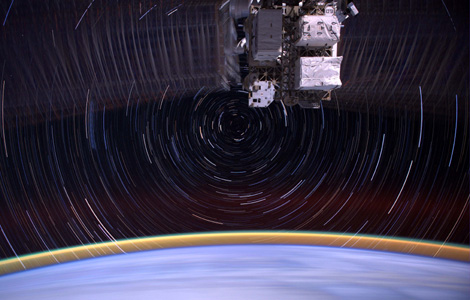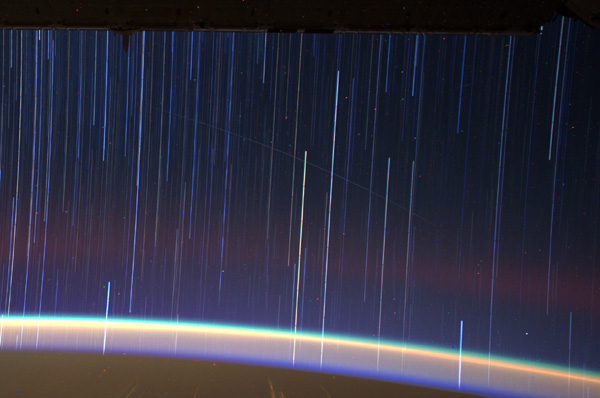The sky is not the limit for producing artistic compositions. Put a camera on a tripod, point at a dark starry sky, and hold the shutter open for about 10 minutes, and the image will show stars as circular arcs. Normally, these star trails are created as the Earth rotates on its axis, with the center being close to either Polaris, the north star, or the Southern Cross, depending on which hemisphere you are in.

I got the idea to do the same thing from Space Station; however, the physics of orbit adds a special twist. As Space Station orbits, it keeps one side always facing the Earth (the nadir direction from our point of view). This requires the Station to complete one revolution about its axis each orbit, just like the Moon. ISS rotates about its center of mass, which happens to be in the Unity, or Node 1 module. So it rotates almost aligned with the Station’s long, backbone-like truss.
Space Station makes one revolution every 90 minutes (the Moon takes 28 days). As a result, long-exposure pictures taken from the Station show star trails as circular arcs, with the center of rotation being the poles of Space Station (perpendicular to our orbital plane). Space Station is inclined 51.6° from Earth’s equator, so the “poles” are now at 38.4°.
My star trail images are made by taking a time exposure of about 10 to 15 minutes. However, with modern digital cameras, 30 seconds is about the longest exposure possible, due to electronic detector noise effectively snowing out the image. To achieve the longer exposures I do what many amateur astronomers do. I take multiple 30-second exposures, then “stack” them using imaging software, thus producing the longer exposure.
Due to our altitude, it is possible to see both the north and south axis of our orbit at the same time. This makes possible star trail images with two circles defined by arcs with opposite inflections. This geometry is hard to arrange from only one window so I use a fisheye lens, one with a full 180° image circle, to make this composition.
In addition to the star trails, many other phenomena of nature can be seen. But I’ll save that topic for another post.

Don’s blog also appears at airspacemag.com.

Very Impressive photos… Great Article and instructions as well.. Thanks for sharing… B
I don’t rely on intelligence
never I believed in it
oh fashion of intelligence
who has said it is the oldest ???
How on Earth (ooops) do you know where you are? The idea of navigating by the stars, from Apollo days, is clearly history.
I just want Don to know that I read his blog with interest and thank him for sharing his space experience with me. Thank you Don!!!!
Kit Richards
32.8N, 105.8W
Interesting photographs. Can you photograph planets without the atmospheric effects we see from earth through the windows on the station? Also, the next transit of Venus will occur on June 5 and 6. Could you photograph this event from the space station?
Lovely pics, thank you 🙂
What’s the eerie red glow just above what I assume is the curvature of the earth (although I’m also curious to know why it’s golden in colour, and why the top bit is yellower and the bottom is bluer).
what is this here for?
Can you see deep-sky objects such as the Andromeda Galaxy from the station?
very cool. thank-you. paul rodgers, nanaimo, bc, canada. ps – that demo you did with the knitting needles, static electricity/magnetism, and water droplets was really cool too.
Nice view of the Earth. A grain of sand trapped in a bubble. I wonder when the bubble will burst and we will be among the stars.
theres an next apollo mission pls tell me
Thank you for these beautiful images. They
Make my soul sing!
These make my heart smile. Thank you.
We are always eager to read more about the universe. Excellent post. Thank you for making science this much fun!